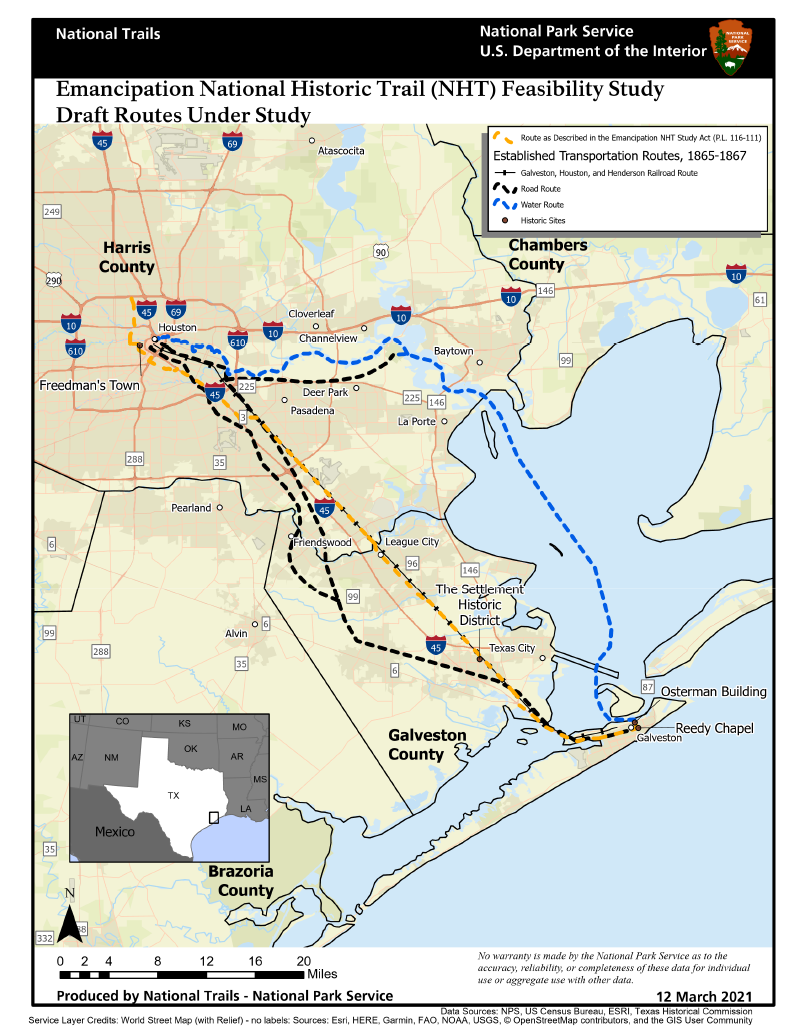August 5, 2024
Emancipation Trail on Track to be a National Historic Trail
51-mile trail a testament to Texas freed slaves
Most Texans are familiar with Juneteenth, now a national holiday, the day in 1865 when Major General Gordon Granger came to Galveston to announce the federal order freeing slaves, which President Abraham Lincoln had announced two years prior. At that point freed slaves began migrating north, along what we now call the Emancipation Trail, from Galveston to Houston.
The trail runs 51 miles from the Osterman Building and Reedy Chapel in Galveston up Texas 3 and Interstate 45 North, through Freedmen’s Town in Houston’s Fourth Ward and then to Independence Heights and Houston Southeast’s historic Emancipation Park in the Third Ward.
Emancipation Park began as a plot of land bought by four of those freed slaves in 1872. The Park was originally used for Juneteenth celebrations, hence the name. In 1916 it was donated to the City as a municipal park. Due to its storied history, the Park was designated a UNESCO Slave Route Project site in 2019, one of seven sites in the City to be included. As such, it is an historical landmark.
And the trail itself is being considered as a National Historic Trail. Thanks, in large part to former Congresswoman Sheila Jackson Lee.
The Congresswoman, who passed in July, left her mark on many projects and causes, but the trail was one she fought hard for, first introducing a bill to authorize a feasibility study (the first step in gaining the National Park Service designation) in 2018, then again in 2019 when HR343 finally passed.
“I applaud passage by the House of Representatives of H.R. 434, the Emancipation National Historic Trail Act,” the Congresswoman said in a press release at the time. “When passed by the Senate and enacted into law, it will result in the second trail in the United States that chronicles the experience of African Americans. Currently, the National Parks Service has only one National Historic Trail which centers on the African American experience. It is the Selma to Montgomery National Historic Trail, which covers a 54-mile path between Selma and Montgomery, Alabama, and which was named a National Historic Trail in 1966. The Selma to Montgomery Trail tells an important story about a pivotal moment in the nation’s struggle transitioning from a history of segregation towards the Civil Rights Movement.
“This trail will be a welcome part of Greater Houston. The City of Houston is fortunate that much of this early history of former slaves has survived to this day: Freedmen’s Town, Independence Heights, and the Emancipation Park areas, which are treasures in our nation’s history. Freedmen’s Town survived where other communities did not, and it is the only surviving 19th century community built by former slaves to have a notable number of original structures that have been protected, preserved, or restored. Freedmen’s Town became the center of opportunity for freed slaves throughout the Houston area. By 1915, over 400 African American-owned businesses existed there. By 1920 one-third of Houston’s 85,000 people lived in Freedmen’s Town.”
In 2020 the Emancipation National Historic Trail Study Act was signed into law by then President Donald Trump. But COVID-19 slowed down the process, which can take years to document and research. The National Park Service is continuing the study and when finished, if Congress votes to make Emancipation Trail a National Historic Trail, it will be a boon to Houston and another star in Congresswoman Sheila Jackson Lee’s legacy.
By Marene Gustin
Photo credit: National Park Service

